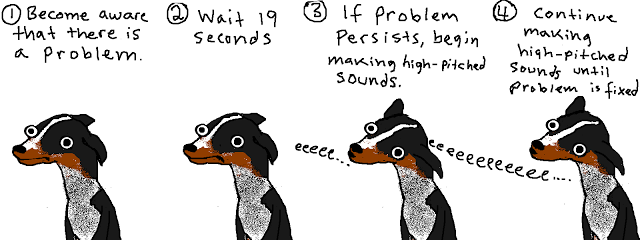Digital Disruption: Organizational Collaboration
Universities and large organizations are good at setting up projects – really good. At any one time, a Higher Education Institution will have projects covering all manner of activities – restructures, new IT systems, adoption of new legislation. They bring people together as a Team under the leadership of a Project Manager. They have budgets assigned to them. They have deliverables which may or may not be achieved. They create reports and ‘lessons learnt’. They are high profile and employees know about them.
And then they stop.
And so do the teams that were created, as well as the focus and attention that the project brought to that issue or opportunity. A project is finite – it has a beginning and an end – which is fine for completing one-off tasks in a timely and cost-effective way. However, digital transformation isn’t a one-off task to be completed. It is a journey, an evolution, a process, and as such, a different approach is required for it to be a success.
That approach is collaboration. Collaboration isn’t a one-off – it’s a culture, a way of working, and needs to be continuous and permeate across the institution continually.
“The age of the collaboration, of the team, of the group, is emerging”, Gerry McGovern
So, what’s the difference between teamwork and collaboration? It comes down to several factors:
• Organizational structures
• Leadership
• Customer-centricity
• Approach to problem-solving
• Institutional culture and resilience
Organizational structures
“Organizational silos are the root cause of most workplace problems and are why many of them never get resolved. This is why today’s new workplace must embrace an entrepreneurial spirit where employees can freely navigate and cross-collaborate", Forbes
Most HEIs (Higher Education Institutions) are large, established organizations whose structures are largely hierarchical and based on outdated modes of operation. Communication is top-down and leadership comes from the senior management team. The organization is divided up into functional teams who share a specialism (e.g. marketing, finance) and, often, larger divisions who are almost autonomous in themselves (e.g. Academic Faculties). Each employee knows their area of specialism, but often this is within the department or Directorate that they are in, rather than being able to place themselves in the overall structure, and success of the organization.
Experts from these functional teams are often brought together, as part of a team, to complete projects which may have gained internal funding, and bring with them an external Consultant to add particular expertise which may be lacking from within the organization. But, as mentioned above, this temporary structure will be just that – temporary – and once the initiative is completed, or the funding has run out, the siloed structures will be reverted to, colleagues will go back to their ‘day job’ and the expertise of the Consultants will go, as their contracted input will cease.
“The hierarchy belongs in a management museum locked up for people to see, but not touch”, Jacob Morgan, Forbes
Structures are changing though – at any one time many HEIs are going through restructures of one sort or another (as I know from very recent experience), but are these addressing the issues outlined above, or just ‘moving the deck chairs’ within that hierarchical structure without actually tackling the need for a true collaborative approach, and the need for flatter, ‘holocractic’ organizations?
If these siloed, hierarchical structures persist, enterprise-wide transformation (of any kind) is unlikely to occur. Flatter, fluid, task-based structures are designed to enable collaboration, communication, ideas and innovative to flourish. But structures are created deliberately; they are designed and implemented. So how can this autonomy make way for a more collaborative environment?
It could come down to how problems are approached.

Approach to problem-solving
Most day to day problems within an organization can be categorised as:
- Tame – have occurred before to someone and there is a degree of certainty about the cause, effect and solution. Usually solved by a management approach, and by repeating what has been done before in a similar situation
- Critical – time-sensitive with little time for decision-making, but can be resolved through adopting a commanding approach, with little, or no, collaboration, until the crisis has passed
- Wicked – have never been encountered before in this context and often there is disagreement about the cause, effect and/or response. Wicked problems require a high level of collaboration to even agree on what the problem is, let alone resolve it.
(Wicked Problems and Clumsy Solutions: the Role of Leadership (Grint, 2008))
Digital transformation (and any process improvement) can be categorized as a Wicked Problem. It is likely that the ‘problem’ is entangled with many other problems (e.g. restructures, budgets, priorities), that there is disagreement as to what it is in the first place, and what approach should be taken to take it forward.
A management or commanding approach will not solve a Wicked Problem. Wicked problems can only be improved through innovative, collaborative and often experimental contributions with strong leadership to engage a collective response. There is no linear approach to gathering data, making decisions and taking action. Often data is gathered which makes the problem even bigger, but the analysis starts to give solutions, but then you analyse it more and the problem gets even bigger – and so on.
Laurence J Peter, the Canadian Educationalist said: “Some problems are so complex that you have to be highly intelligent and well informed just to be undecided about them.”

It is about asking questions rather than always providing answers. It is about reflection rather than reaction. It is about collective intelligence rather than individual genius. It is about being empathetic rather than egotistical. And it is about building a community of fate rather than letting a fatalistic community prevail.
And, therefore, a collaborative, leadership style must be adopted.
Leadership
Traditional hierarchical structures lend themselves well to autocratic models of organizational behaviour where decisions and communication are very top-down, and the structure is based around the relative status and authority of the people within the organization, rather than being structured to provide the best outcome for the customer. Leadership is seen as a ‘role’ rather than a culture, or is assigned to an individual to get a task done, e.g. a Project Manager.
As mentioned previously, collaboration isn’t a one-off activity. Its continuous adoption should take the place of short-term projects which, when complete, dissolve collaborative teams and activities. And for this to be a success, encouraged and recognized, an organization’s approach to Leadership must adapt and evolve.
“The new model requires leaders everywhere, a team spirit and a collaborative environment. The hierarchical ‘leadership from the top’ old model is broken”, Gerry McGovern
A different type of Leadership is required – one that permeates the organization; one that truly believes that power is greatest in a collective team rather than one individual controlling all the decisions; one that fosters respect amongst the group, and one that encourages (and rewards) a group approach to problem-solving.
Employees need to be empowered to collaborate and look for better ways of working for the greater good, which requires a mind shift in leaders who have traditionally been bureaucratic and hierarchical, requiring permission to be granted, rather than initiative encouraged. Employees should be inspired to not just wait for collaborative projects to be created, but to create opportunities themselves.
Conversations should be encouraged where trust and transparency underpin interactions and bad ideas are listened to and heard – after all, bad ideas often lead to good ideas, which lead to great ideas.
"Collaboration needs a different kind of leadership; it needs leaders who can safeguard the process, facilitate interaction and patiently deal with high levels of frustration.”
David Chrislip, The Collaborative Leadership Fieldbook - A guide for citizens and civic leaders.
But this new approach to leadership requires a new focus – leaders must start to look outwards, rather than inwards.
Customer-centricity
All HEIs have a strategy – but a lot of them are more or less, the same! Increased student recruitment, more research income, greater internationalisation…it’s all about the organisation. And it’s getting progressively difficult to be distinctive and stand out in an over-crowded, global marketplace.
A sure-fire way to make a good start is to be more customer-centric, and less organisation-centric.
“A customer-centric approach can add value to a company by enabling it to differentiate itself from competitors who do not offer the same experience”, Business Dictionary.com
How many organizations have strategic goals and objectives that are about making the prospective, and current, customer’s lives easier and enabling them to carry out their ‘top tasks’ quickly and efficiently? Not many, I would wager.
Without this focus on the customer, collaboration gets trickier, as siloed departments continue to work independently of each other to achieve their bit of the organizational strategy, rather than working together to identify what customers want and need, and then collaborating, on an ongoing basis, to continuously improve their experience.
In the corporate world, it’s not unusual to see roles such as Head of Customer Experience, where a holistic view is taken of the customer and their tasks across all departments. Collaboration across these different areas is fundamental to the success of the customer experience, and therefore the organization. If the customer has a terrible experience they will take their custom elsewhere and the organization will suffer thus.
“Collaboration leads to greater value and higher profit”, Heidi K. Gardner, Harvard Law School
HEIs need to start to take a leaf out of this customer-centric book. Who in your organization is responsible for the customer (in its widest sense – internal and external) and understands what they need and want, and fosters collaborative relationships to achieve this? If you can’t find anyone, make it you…start those conversations, make connections and begin to put the customer first.
Organizational culture and resilience
Structure, and approaches to problem-solving and leadership styles are all outputs of an organizational culture – the fundamental lynchpin of how people behave therein.
Siloed departments and divisions often have their own cultures, that have arisen over time, either due to strong personalities, cliques, or ways of working, and these can often rub up against each other when teamwork is required. We’ve all been part of project teams where colleagues from different departments behave or work differently, and the phrase ‘that’s not how we do it’ crops up with alarming regularity.
True collaboration is only achievable when there is one shared, customer-centric vision, that all employees believe in, and a consistent culture permeates throughout. This doesn’t require everyone to be best of friends, but listen to, understand, and respect each other’s ideas, opinions and suggestions.
“Healthy respect, rather than warm affection is all you need to underpin a good collaboration”, Helsinki Design Lab
People behaviours also contribute to Organizational Resilience, which the BSI describes as “the ability of an organization to anticipate, prepare for, respond and adapt to incremental change and sudden disruptions in order to survive and prosper.”

Summary
Digital Transformation is digital disruption under another name. Technology is transforming industries and it is up to the organization to decide how it is going to respond.
A collaborative culture, with strong leadership throughout, a collective approach to problem solving, and a flatter organisational structure are the ingredients of a recipe for success.
For true collaboration to occur, ranks and levels of importance need to be stripped back, to make way for talent, innovation, ideas, distributed decision-making, employee empowerment, devolved leadership, and giving everyone the opportunity to work on what they do best.
Why wouldn’t any organization want this?
Author: Claire Gibbons, Digital, Marketing, Higher Education and Content Consultant.
https://twitter.com/PlanetClaire

:format()//media/Digital-Disruption_-Organizational-Collaboration_RQ.png)